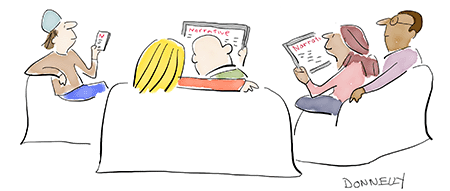The painter’s house on the hill is ablaze with light, though tiny against the darkness. The painter is not easy to find. People see him around—in Inverness, California, where he has a studio, and in Marshall, where he lives—but he has an elusive quality, disappearing into his work for long stretches. He’s the greatest living landscape painter in America, famous for his outlandish appetites for food, wine, travel, art, music, literature, and the sporting life.
No one I know is more of a financial wreck than Russell Chatham. For decades, his creditors have been hounding him. The IRS has been garnishing his wages while he tries to paint his way out of the last century and into the next. It makes no sense—even the smallest of his paintings sells for tens of thousands of dollars, while a large commission is an honest seven figures, yet his debts are huge. He spends forever on each painting, getting it just right. His deepest vice is fishing; other than painting, it’s his greatest obsession, one that has been with him all his life. Anytime he gets some money, he goes fishing somewhere. There aren’t many places left in the world where he hasn’t been. Tom McGuane, who was his friend and neighbor when Russell was living in Montana, has called him “a man who has ruined his life with sport,” one who “skulks from his home at all hours with gun or rod.”
Always I study Russell closely, with fascination, admiration, and the tingle of adrenaline that can precede either great accomplishment or a grand wipeout. At seventy-four, he’s painting as well as he ever has, with some new tender subtleties coming in. Now a haze creeps into the cottonwood bottoms along the Yellowstone River when he paints it in absentia here on the ridges above Tomales Bay.
My mentee Erin and I wind our way up the long gravel road that leads to Russell’s ridgetop, past the grove of giant eucalyptus, isolated among all the tall grasses of the rolling hills. He’s always chosen the most beautiful places to live (back in Montana it was along Deep Creek, in the aptly named Paradise Valley), and when Erin and I finally pull in, the night is scented with blooming roses, and every window of the house burns yellow in the darkness. We can hear opera music—Wagner? Puccini? Is there a party going on?—but there are no other cars. The music’s too loud for a knock to do any good, so I open the door, and the sound washes over us like floodwaters released by the bursting of a dam.
Elegance within: all the surfaces are clear, save for a pen and a notebook, a laptop, a bowl of fruit. His magazines (Wooden Boat, Saltwater Fisherman, The New Yorker) are arranged neatly on the coffee table. Erin was dubious about coming here—a painter as a writer’s hero?—and this full-volume hilltop opera in what seems to be an abandoned house is doing nothing to convince her otherwise. But although Russell is also a writer, and a good one, it’s his paintings that have informed me most as a writer and a Westerner. They are the reason I want Erin to meet him. Moreover, these words from his essay “Advice for a Young Painter” are just as appropriate for young writers: “First and foremost, determine if wanting to be a painter is just a passing romantic or otherwise fanciful notion or whether in fact it is a genuinely primal calling you must follow to be whole. Then, know what you’re getting into. The number of people in America today who can understand and appreciate real painting is about the same as the number of wild condors in California.”



